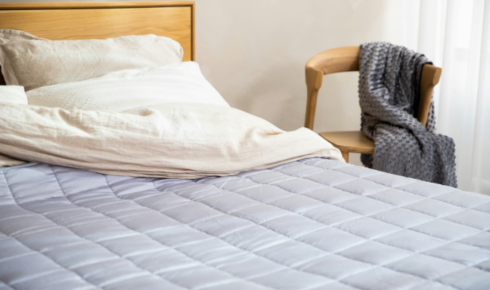You do everything right. You go to bed at a decent hour, you turn off your phone, and you get your recommended eight hours. So why do you still wake up feeling like you’ve been in a wrestling match all night? That persistent lower back ache, the stiffness in your neck, the general feeling of being tired and sore—the culprit might be hiding in plain sight.
Your mattress.
Over time, the bed that was once your comfortable sanctuary can betray you, slowly transforming into the source of your sleep problems. But how can you be sure? And if it is the problem, how do you even begin to navigate the overwhelming world of modern mattresses to find a replacement?
This is your practical, step-by-step guide to becoming your own sleep detective. We’ll show you how to first prove that your mattress is the problem, and then how to confidently choose the perfect new one to reclaim your right to a restful, pain-free night.
Your Step-by-Step Guide to a Better Night’s Sleep
We’ll break this journey down into two simple parts. First, we’ll conduct a thorough diagnosis of your current mattress. Second, we’ll explore the key factors in finding your ideal sleep sanctuary.
Part 1: How to Diagnose Your Ailing Mattress
Is your mattress really the source of your aches and pains, or is it something else? Before you spend a dollar, it’s important to gather the evidence.
Are You Just Imagining It? The Telltale Signs of a Failing Bed
Your body often knows your mattress is failing before your eyes do. Listen to the subjective clues it’s giving you:
- You wake up sore: This is the number one sign. If you go to bed feeling fine but wake up with new aches, your mattress is likely not providing proper support, forcing your muscles to work all night to keep your spine aligned.
- You sleep better elsewhere: Do you get a fantastic night’s sleep in a hotel bed, only to have your aches return the moment you’re back home? That’s a huge red flag.
- The “hammock effect”: You feel like you’re sinking into a crater in the middle of the bed, or you and your partner are constantly rolling toward each other.
- It’s just old: The average lifespan of a quality mattress is around 7-10 years. If yours is older than that, it’s living on borrowed time.
The Objective Proof: Putting a Number on the Sag
Feelings are important, but objective data is better, especially if you think your mattress might still be under warranty. You need to prove that the sag is real, and you can do that with a simple, five-minute test.
This might sound technical, but it’s incredibly easy. You just need a piece of string (or a yardstick/broom handle) and a ruler. By stretching the string tightly across the mattress, you create a straight line that reveals the true depth of the dip. For a detailed, step-by-step visual guide that walks you through the entire process, this is exactly how to measure mattress sag like a pro. This will give you the undeniable proof you need to either file a warranty claim or simply confirm that it’s time to go shopping.
Part 2: How to Find Your Perfect New Sleep Sanctuary
So, you’ve confirmed it: your old mattress is done. Now, the exciting but often overwhelming search for a new one begins. Between bed-in-a-box brands, memory foam, latex, hybrids, and confusing marketing terms, it’s a lot to take in. But you can cut through the noise by focusing on what truly matters.
The Most Important Factor: Your Sleep Position
More than any other factor, your primary sleep position should dictate your mattress choice. The goal is to keep your spine in a neutral, straight alignment all night long.
- Side Sleepers need a slightly softer mattress that allows their shoulders and hips to sink in, relieving pressure.
- Back Sleepers typically need a medium-firm mattress that supports the natural curve of their spine without causing them to sink too deeply.
- Stomach Sleepers need a firm mattress to prevent their hips from sinking, which can cause the back to arch unnaturally.
The “Combination Sleeper” Conundrum
Here’s the reality: most of us don’t stay in one position all night. We toss, we turn, we switch from our side to our back. We are “combination sleepers.” And if you share your bed with a partner, you might have two completely different sleep styles and preferences to accommodate.
This is where mattresses with a “universal comfort” or medium-firm feel truly shine. They are designed to be an adaptable middle ground, offering enough cushioning for side sleeping and enough support for back sleeping. To navigate the many excellent options designed for this exact purpose, a curated guide to the best mattress for all sleep positions is the perfect resource, especially for couples and restless sleepers.
Don’t Forget the Sleep Trial!
This is perhaps the most important innovation in modern mattress buying. You can’t know if a mattress is right for you by lying on it for five minutes in a showroom. Reputable online mattress companies offer at-home sleep trials, typically for 100 nights or more. This gives your body weeks to adjust and truly decide if the mattress is a good fit. A generous, hassle-free return policy is the ultimate assurance that you won’t get stuck with a mattress you don’t love.
Waking up feeling tired, sore, and unrested does not have to be your normal. By taking a methodical, two-part approach, first by objectively diagnosing your current mattress and then by choosing a new one based on the science of your sleep style, you can take back control of your nights. The impact of a truly great mattress goes far beyond the bedroom; it can improve your energy, your mood, and your entire quality of life.

